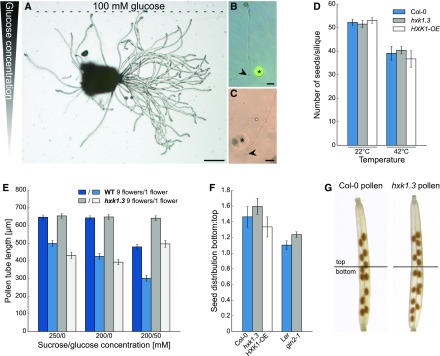Figure 10.
Analyses of Hypotheses on the Physiological Functions of Glucose on Pollen Tube Growth.
(A) to (C) Influence of glucose gradients on pollen tube growth direction.
(A) Representative image of semi-in vivo growing pollen tubes challenged with a linear glucose gradient in the germination medium. The glucose gradient across the pollen germination medium was established by pipetting gelatin containing 100 mM glucose in a small band along one side of the pollen germination pad at the beginning of the growth assay.
(B) and (C) Growth of pollen tubes when gelatin beads containing 500 mM glucose (asterisk) were placed in close proximity to the pollen tube tips (arrowheads). In (B), carboxyfluorescein was added in addition to the gelatin beads to monitor possible diffusion.
(D) Number of seeds produced by Col-0, hxk1.3, or HXK1-OE plants under normal conditions (22°C) and after heat stress (42°C for 3 h). n ≥ 10 siliques from different plants for every genotype under each temperature condition.
(E) Mean lengths ± se of hxk1.3 and wild-type pollen tubes germinated in vitro for 7 h. Samples were either prepared by spreading the total pollen of one flower or of nine flowers on the cellulosic membrane of the germination media with different sugar concentrations (n ≥ 200 pollen tubes for each genotype on every sugar concentration).
(F) Distribution of seeds in the top and bottom half of Col-0 siliques after pollination with minimal amounts of Col-0, hxk1.3, HXK1-OE, Ler, or gin2-1 pollen. Means ± se of three independent experiments with n ≥ 50 siliques of every genotype in total. Independent experiments were performed with different pistil and pollen donor plants on different days.
(G) Representative image of siliques pollinated with limited amounts of Col-0 or hxk1.3 pollen. Top and bottom part as defined for the measurements shown in (F) are indicated.

